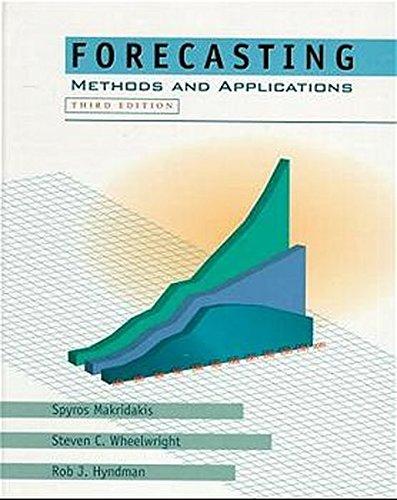Question
The table below shows data on the returns over five 1-year periods for seven mutual funds. A firm's portfolio managers will assume that one of
The table below shows data on the returns over five 1-year periods for seven mutual funds. A firm's portfolio managers will assume that one of these scenarios will accurately reflect the investing climate over the next 12 months. The probabilities of each of the scenarios occurring are 0.1, 0.3, 0.1, 0.1, and 0.4 for years 1 to 5, respectively.
RETURNS OVER FIVE 1-YEAR PERIODS FOR SEVEN MUTUAL FUNDS
Planning Scenarios for Next 12 Months Mutual Funds Year 1 Year 2 Year 3 Year 4 Year 5 Large-Cap Stock 35.3 20.0 28.3 10.4 -9.3 Mid-Cap Stock 32.3 23.2 -0.9 49.3 -22.8 Small-Cap Stock 20.8 22.5 6.0 33.3 6.1 Energy/Resources Sector 25.3 33.9 -20.5 20.9 -2.5 Health sector 49.1 5.5 29.7 77.7 -24.9 Technology Sector 46.2 21.7 45.7 93.1 -20.1 Real Estate Sector 20.5 44.0 -21.1 2.6 5.1
- Develop a portfolio model for investors who are willing to risk a portfolio with a return no lower than 2%. Round your answers to one decimal place. For subtractive or negative numbers use a minus sign even if there is a + sign before the blank. If the constant is "1" it must be entered in the box.
- To determine the percentage of the portfolio that will be invested in each of the mutual funds we use the following decision variables:
- LS = proportion of portfolio invested in a large-cap stock mutual fund
- MS = proportion of portfolio invested in a mid-cap stock fund
- SS = proportion of portfolio invested in a small-cap growth fund
- ES = proportion of portfolio invested in an energy sector fund
- HS = proportion of portfolio invested in a health sector fund
- TS = proportion of portfolio invested in a technology sector fund
- RS = proportion of portfolio invested in a real estate sector fund
- s.t. LS + MS + SS + ES + HS + TS + RS
- LS + MS + SS + ES + HS + TS + RS LS + MS + SS + ES + HS + TS + RS LS + MS + SS + ES + HS + TS + RS LS + MS + SS + ES + HS + TS + RS LS + MS + SS + ES + HS + TS + RS LS + MS + SS + ES + HS + TS + RS LS, MS, SS, ES, HS, TS, RS 0
- Solve the model in part (a) and recommend a portfolio allocation for the investor with this risk tolerance. Round portfolio return to three decimal places and other answers to one decimal place. If your answer is zero, enter "0".
- The recommended allocation is to invest as follows:
- % of the portfolio in the large-cap stock mutual fund % of the portfolio in the mid-cap stock fund % of the portfolio in the small-cap stock fund % of the portfolio in the energy sector fund % of the portfolio in the health sector fund % of the portfolio in the technology sector fund % of the portfolio in the real estate sector fund
- The expected portfolio return is %.
- Modify the portfolio model in part (a) and solve it to develop a portfolio for an investor with a risk tolerance of 0%. Round portfolio return to three decimal places and other answers to one decimal place. If your answer is zero, enter "0".
- The recommended allocation is to invest as follows:
- % of the portfolio in the large-cap stock mutual fund % of the portfolio in the mid-cap stock fund % of the portfolio in the small-cap stock fund % of the portfolio in the energy sector fund % of the portfolio in the health sector fund % of the portfolio in the technology sector fund % of the portfolio in the real estate sector fund
- The expected portfolio return is %.
- Is the expected return higher for investors following the portfolio recommendations in part (c) as compared to the returns for the portfolio in part (b)?
- If so, do you believe the returns are enough higher to justify investing in that portfolio?
- Most investors would conclude that the small increase in the portfolio return to justify the increased risk.
Step by Step Solution
There are 3 Steps involved in it
Step: 1

Get Instant Access to Expert-Tailored Solutions
See step-by-step solutions with expert insights and AI powered tools for academic success
Step: 2

Step: 3

Ace Your Homework with AI
Get the answers you need in no time with our AI-driven, step-by-step assistance
Get Started


